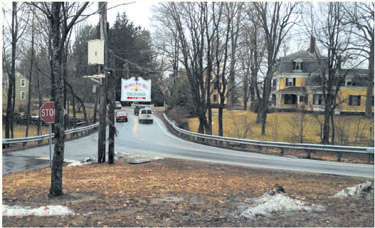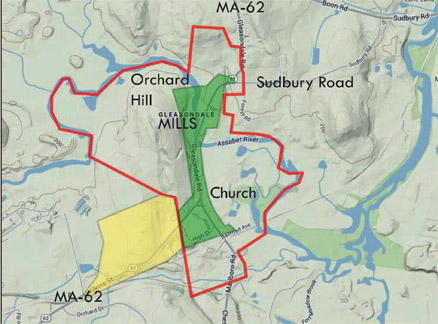

By Ellen Oliver
On Wednesday June 26, residents were invited to hear a presentation on the initial findings of a study by UMass Amherst students on the Gleasondale area of Stow. Gleasondale Village was the focus of a graduate student class from UMass Amherst’s Center for Economic Development. For their semester-long project, the students worked with Town Planner Karen Kelleher and Assistant Town Planner Jesse Nathan Steadman to consider the future of Gleasondale Village, with a focus on the Gleasondale Mill.
About 40 people attended the presentation. “The students spent the whole semester on the planning process,” said Kelleher. “They did an inventory, toured the mill and looked at opportunities and constraints.”
In the presentation, the students listed the main characteristics of the Gleasondale Village, describing how its location away from other town centers, the unique range of structures and styles, as well as the presence of the river and farm, present an unexpected village center. They also stated that the area has not seen growth beyond its original scale.
They also indentified constraints to any planning efforts, with the top concern a familiar song in Stow: water. “One of the biggest constraints identified by the students is the lack of water and sewer services in the area,” said Kelleher. Along with parking issues, the study also stated that there are several groups active in the Village, but without a platform for working together on common concerns.
The residents of Gleasondale were happy the Village, especially the mill, is getting planning attention and agreed that water and sewer constraints could make implementation a challenge. “People go by the mill everyday and don’t realize what’s there. It’s great what they are talking about, but without financial backing it’s not going to happen,” said Bob Cutler, longtime resident of Gleasondale Village.
The report also indicates that Gleasondale Village is near many area attractions, but does not contribute to or take

Courtesy UMass
advantage of them. “We have a golf course that does weddings nearby, but few places to stay,” said Kelleher.
With a focus on preserving the mill identity of the area, Kelleher said the town was lucky to get this class with this professor, John Mullen, who has been involved with many mill revitalization projects. ”He also grew up in Maynard and was involved with Clock Tower Place, so he knows the area,” said Kelleher.
Capitalizing on Mullen’s experience, the students presented case studies from other mill areas to show what the future could hold for Gleasondale Village.
The students didn’t just present their study findings; they developed a plan for the town, with a short list of actions to be taken in the first 90 days. Among the ideas to consider is leveraging the artisan community that currently exists at the mill by promoting a woodworkers’ collective and offering seasonal markets to complement tourism activities. They also suggested improving the boating access to encourage more bonding with the river.
On the technical side, the students recommended pursuing a National Register listing for the mill and investigating relicensing of the dam, suggesting the town “balance preservation with progress.”
One of the top recommendations was to begin a dialogue with the community. “One of the first things for us to do is create a neighborhood group,” said Kelleher. “Some people wanted to know why the students didn’t knock on their doors. When they left, I think they understood the study was a product to start a conversation with residents.”
A neighborhood group would work with the town to collaborate on solutions, including participating in a design charrette to identify input and feedback. The Cutlers said the community is already close, but keeping in touch is difficult when crossing the busy Route 62. “I’d like to see a sign for Gleasondale, like there is for the Lower Village,” said Bob Cutler. The signs would help define the Village, but also indicate to drivers to anticipate people crossing the road. “They see the houses, but don’t expect to see people,” added Mary.
Kelleher said the UMass study will work in conjunction with a study being conducted by the Historical Commission. “The Historical Commission is doing a historic building inventory and are considering a tour of historic homes,” she said. “They just finished Gleasondale, so a historic house tour would be a nice kick-off to this process.”
The meeting was to present the initial findings of the study, with a more detailed report available in a few weeks. For a copy of the presentation visit the Stow Planning Board blog at: http://stowplanning.wordpress.